Hammerhead Shark
Sphyrnidae
They have a 360 field of view
Advertisement
Hammerhead Shark Scientific Classification
- Kingdom
- Animalia
- Phylum
- Chordata
- Class
- Chondrichthyes
- Order
- Carcharhiniformes
- Family
- Sphyrnidae
- Scientific Name
- Sphyrnidae
Read our Complete Guide to Classification of Animals.
Hammerhead Shark Conservation Status
Hammerhead Shark Facts
- Prey
- crustaceans, fish, cephalopods, stingrays
- Group Behavior
- Solitary/School
- Fun Fact
- They have a 360 field of view
- Estimated Population Size
- Unknown
- Biggest Threat
- Overfishing, shark culling
- Most Distinctive Feature
- Hammer-shaped head
- Other Name(s)
- sphyrnids
- Gestation Period
- 10-12 months
- Habitat
- coastal, continental shelves
- Predators
- Tiger Shark, Great White Shark, Killer Whale, Humans
- Diet
- Carnivore
- Average Litter Size
- 26
- Lifestyle
- Herd
- Favorite Food
- Fish
- Type
- sphyrnids
- Common Name
- hammerhead shark
- Number Of Species
- 10
- Slogan
- Found in coastal waters around the world!
View all of the Hammerhead Shark images!
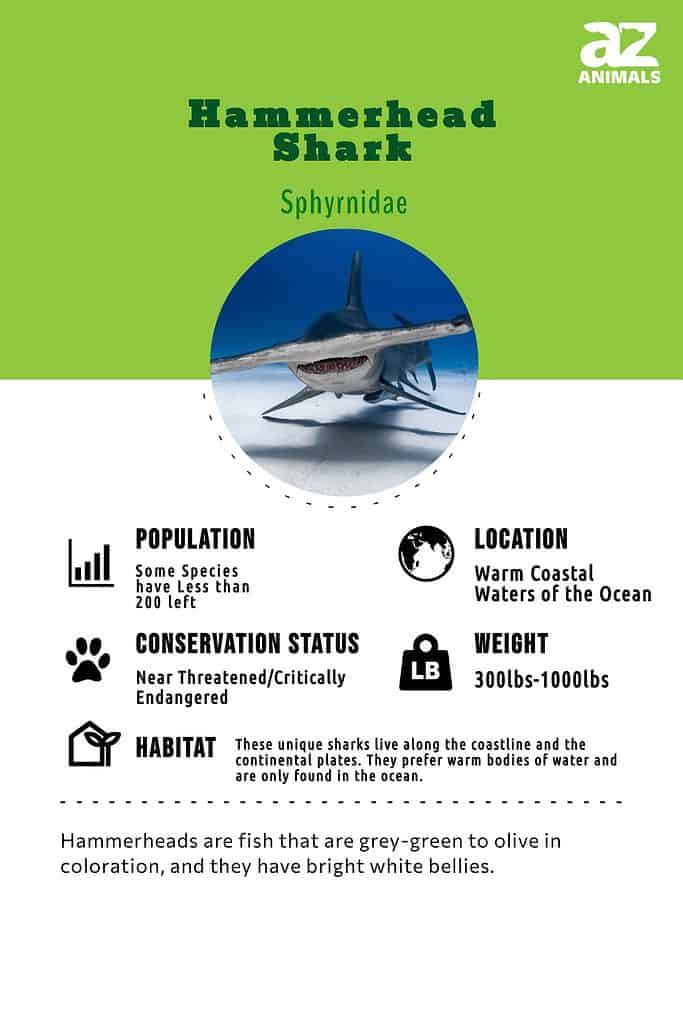
Hammerhead sharks are best known for their long, rectangular heads.
Hammerhead sharks are best known for their long, rectangular heads. These distinctive heads serve multiple purposes, including granting the sharks 360-degree vision as well as better hunting abilities. Hammerhead sharks populate coastal areas and the edges of continental plates.
4 Hammerhead Shark Facts!
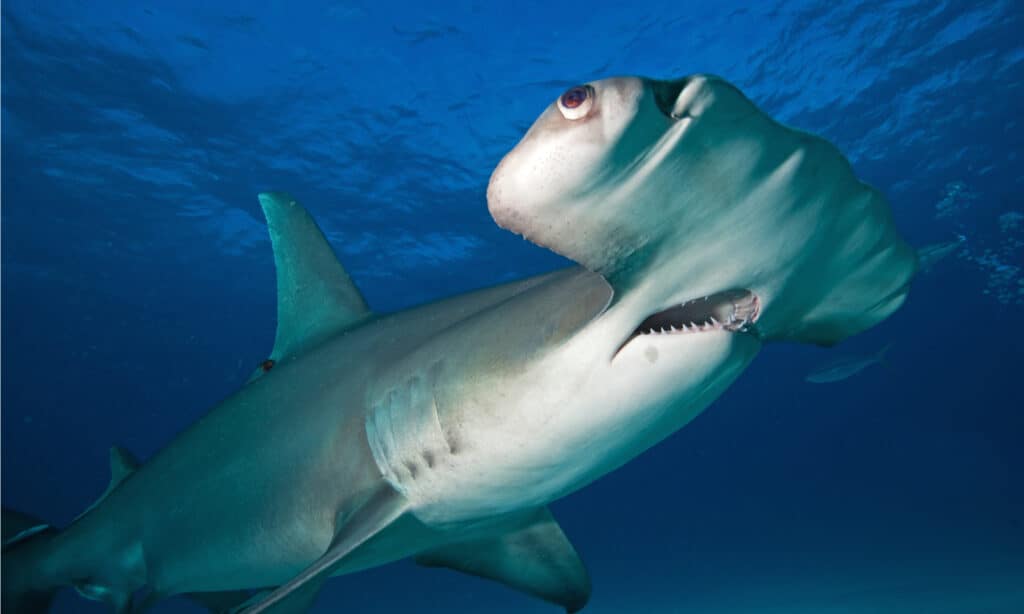
Hammerhead sharks are found in warm coastal waters.
©Martin Prochazkacz/Shutterstock.com
- Lovers of warmth: Hammerheads are fish that prefer warm coastal waters.
- Efficient swimmers: Hammerhead sharks tend to swim at an angle to decrease drag and increase their swimming efficiency.
- Going green: One species of hammerhead, the bonnethead shark, is actually omnivorous, as it eats sea grass.
- Better hunters: The long heads of the hammerhead shark allow the sharks to spread out their special sensory organs, giving them a hunting advantage over other sharks.
For more hammerhead shark facts, make sure to give ‘10 Incredible Hammerhead Shark Facts‘ a read!
Classification and Scientific Name
These sharks are in the class Chondrichthyes, or cartilaginous fishes. Their order is Carcharhiniformes, which have two dorsal fins, and five-gill slits, and is the largest order of sharks.
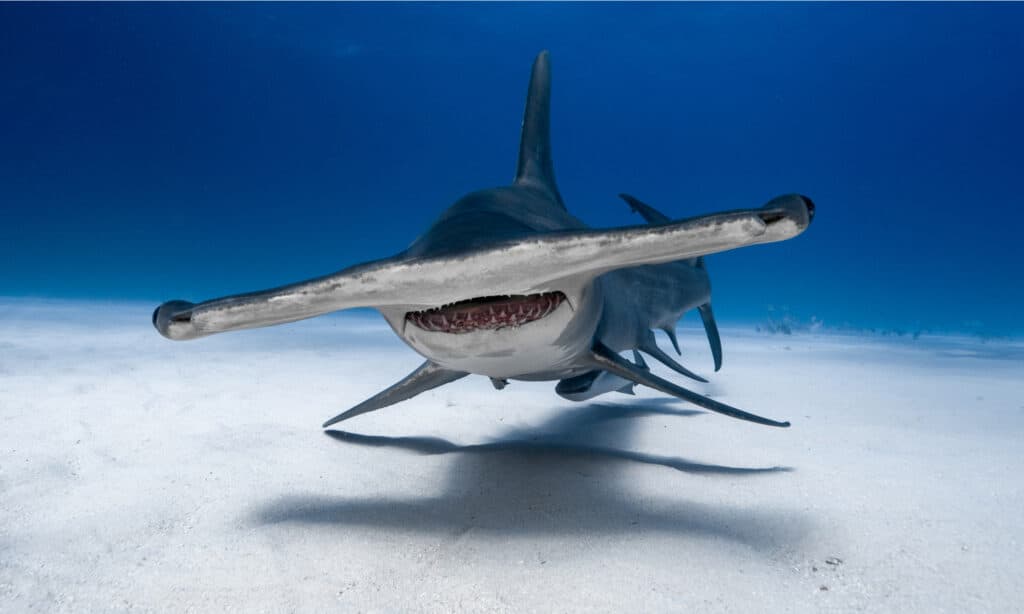
These sharks are in the class
Chondrichthyes,or cartilaginous fishes. Their order is
Carcharhiniformes. The family scientific name for hammerhead sharks,
Sphyra, is the Greek word for “hammer.”
©Sail Far Dive Deep/Shutterstock.com
The family Sphyrnidae are the hammerheads, which include the genus Sphyrna and the genus Eusphyrna. Sphyrna includes the nine species of true hammerheads, and Eusphyrna includes only one species, the winghead shark.
The family scientific name for hammerhead sharks, Sphyra, is the Greek word for “hammer.”
Evolution and Origins
Hammerhead sharks first appeared in oceans close to 20 million years ago. They were actually as big as some contemporary hammerhead sharks today. In modern times, there are about 530 species of shark and ten species of hammerhead sharks alive as of 2023.
It is acceptable to believe that hammerheads evolved from a single carcharhinid ancestor with a normal-shaped head. It is believed that the shape of the hammer has evolved over time over millions of years.
Additionally, a recent study suggests that the hammerhead shark evolved its hammer-shaped snout to boost the animal’s vision and hunting process. Although argued in the past, most believe that having eyes so wide apart actually helps vision rather than hinder it.
Shark Species
There are nine species of true hammerhead sharks, with most of them being smaller sharks and a few, such as the great hammerhead shark, being large enough to pose a threat to humans.
These are the nine different species of hammerhead shark:
- Winghead Shark
- Scalloped Bonnethead
- Whitefin Hammerhead
- Scalloped Hammerhead
- Scoophead
- Great Hammerhead
- Bonnethead
- Smalleye Hammerhead
- Carolina hammerhead
Some are named after the shape of their heads, such as the bonnethead shark. Some, such as the scalloped hammerhead, are named after features on their heads. The scalloped hammerhead features a row of ridges along the front of its face.
The winghead shark is an ancient breed of hammerhead, as its head is significantly larger in proportion to the rest of its body.
Shark Appearance
Hammerheads are fish that are grey-green to olive in coloration, and they have bright white bellies. These bellies allow them to disguise themselves against the brightness of the ocean surface while hunting prey. Hammerheads have small mouths in proportion to their heads. Their teeth are serrated and tiny. Their eyes sit at the edges of their face, granting them a wide field of view. They have 5-gill slits.
The unique head of these sharks serves purposes beyond great vision. Like most sharks, hammerheads use sensory organs in their face to detect the electrical impulses given off by other creatures. These organs aid in locating and catching prey.
The hammerhead shark family has increased detection abilities because their sensory organs are spread throughout their heads. This spread allows them to find food, such as stingrays, on the sandy ocean floor.
These sharks can be as small as 0.9m and as long as 6.1m. They have tall, pointed dorsal fins. Some species have a notch on the end of their tails.
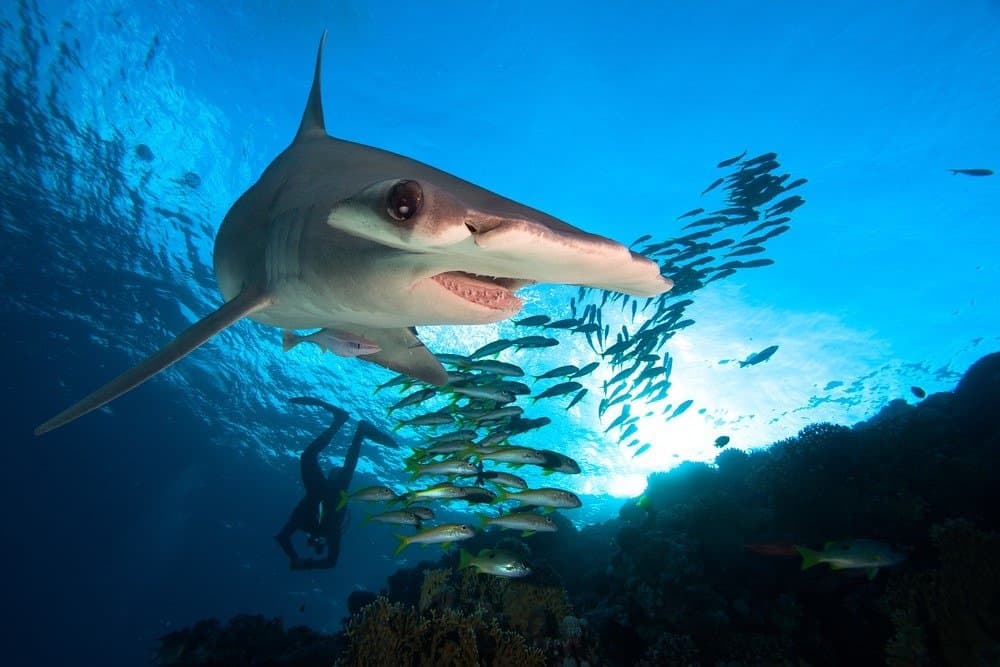
Hammerhead shark and school of fish
©frantisekhojdysz/Shutterstock.com
Distribution, Population, and Habitat

These unique sharks live along the coastline and the continental plates. They prefer warm bodies of water and are only found in the ocean.
©Ruslan Harutyunov/Shutterstock.com
These unique sharks live along the coastline and the continental plates. They prefer warm bodies of water and are only found in the ocean. These sharks migrate when the seasons change; they move to the poles during the summer and to the equator during the winter. Populations of these sharks are dense around Hawaii, Costa Rica, and Eastern and Southern Africa.
Some species form schools of hundreds of individuals by day. These schools are primarily female hammerheads. By night, most species are solitary hunters.
Populations of most species of hammerhead sharks have been in decline, with some species listed as threatened while others are critically endangered.
Predators and Prey
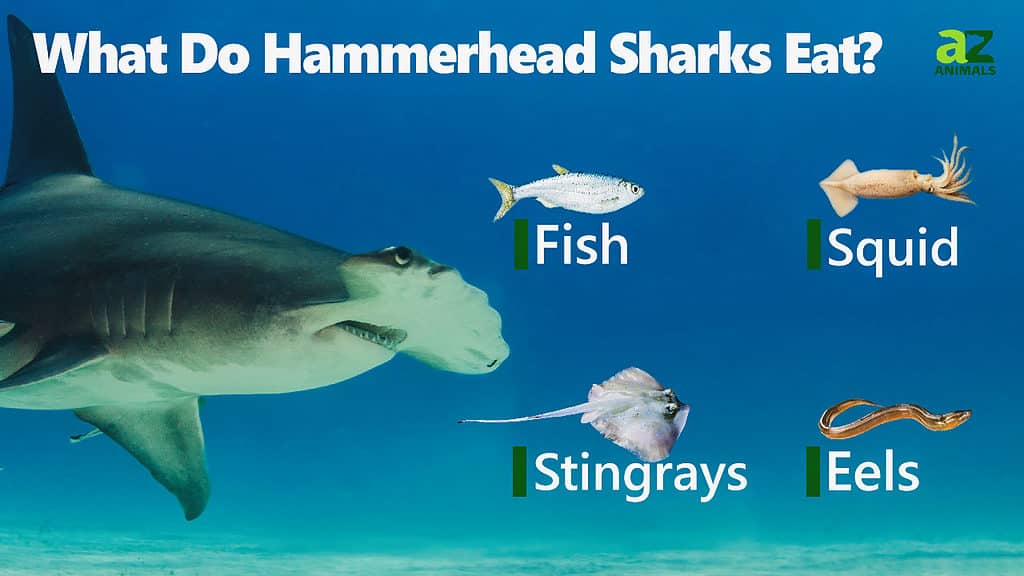
Hammerheads tend to be carnivorous creatures. They will feed on fish, crustaceans, and cephalopods. A particular favorite of hammerheads is stingrays. They will use their enhanced sensory abilities to find them buried in the sand and then pin them down using their heads.
Hammerheads prefer to hunt in shallow waters, and some species even venture into bays and brackish waters to find prey. A 2005 study examined the stomach contents of 556 hammerhead sharks and found their most common prey were small squids, fish, and their stomachs even included moray eel! You can read more about their diet in ‘What Do Hammerhead Sharks Eat.‘
If the sharks are unable to find food, they have been known to eat their own young. They are considered to be better predators than other species of sharks.
Hammerheads have no natural predators. Humans are the biggest threat to these species, as they are fished deliberately for their fins or occasionally accidentally caught in fishing nets.
To know if hammerheads are dangerous to humans, read here.
Reproduction and Lifespan
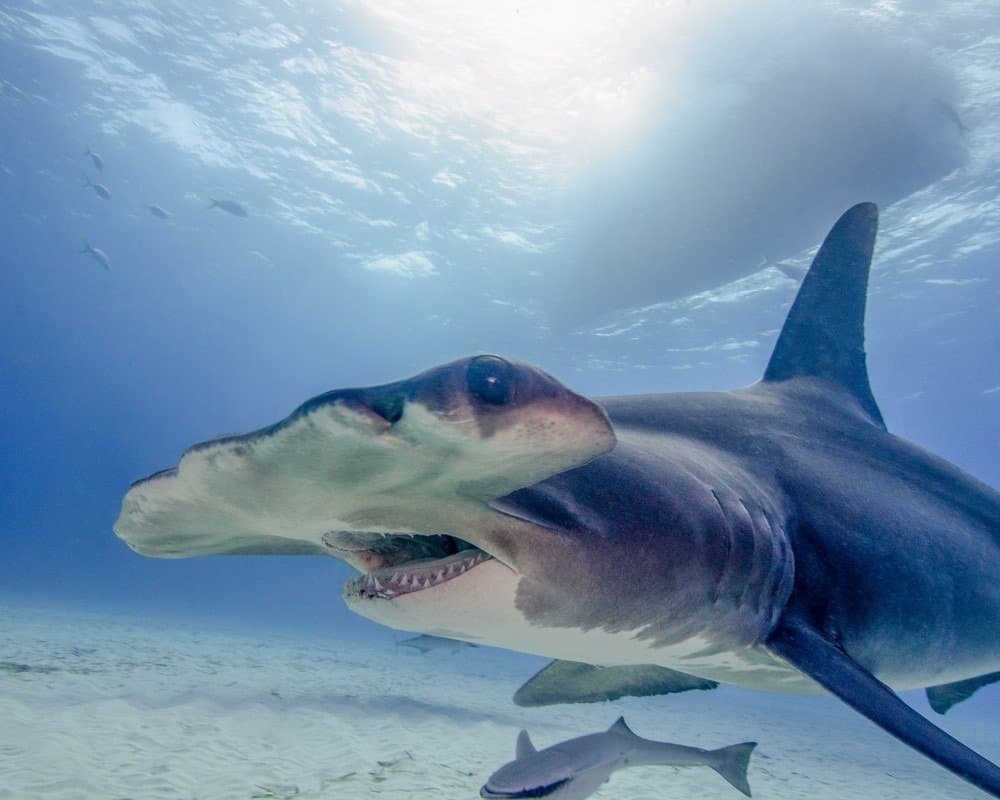
Great Hammerhead Shark in the Bahamas with a baby.
©Brent Barnes/Shutterstock.com
These sharks reproduce in the spring and summer months. Their breeding season is annual, unlike other species of shark. The male bites the female viciously until she allows him to mate with her. However, she can chase him away if she is not interested in him.
This process can take hours until the female decides to submit to a mate. These sharks have thick skin, which means the mating rituals aren’t painful, though older females often have scars from the bites.
Hammerheads fertilize their eggs internally, making for a safe environment for the young to develop. Females give birth to live young after a 10 to 12-month gestation period. Pups are born in shallower waters and left to fend for themselves. They swim to deeper waters once they are older.
Fishing and Cooking

Hammerhead sharks are one of many species of sharks who suffer from the shark finning industry.
© EDGAR PHOTOSAPIENS/Shutterstock.com
These sharks are one of many species of sharks who suffer from the shark finning industry. Shark finning is when sharks are harvested for their fins and then tossed back to sea, often while still alive. Shark fins are illegally used in medicinal remedies, as well as shark fin soup. These sharks are also prized as sport fish.
Millions of sharks are finned every year, and hammerhead populations suffer enormously from this. However, since they reproduce once a year, hammerheads can replenish their populations faster than other species of shark can. Most sharks are slow to breed and reproduce, so their numbers simply cannot keep up with the population decline caused by shark finning.
More on Hammerhead Sharks
Similar Animals:
- Largest hammerhead shark ever recorded: Check out this giant specimen!
- Scalloped Hammerhead Shark vs Great Hammerhead Shark: Two great sharks go hammerhead to hammerhead!
- Hammerhead Shark Location: Where Do Hammerhead Sharks Live?: Find out where hammerhead sharks live and hunt.
- 10 Incredible Stingray Facts: Find out more about the hammerhead sharks’ favorite food!
Hammerhead Shark FAQs (Frequently Asked Questions)
Do hammerhead sharks attack people?
Only one species of shark, the great hammerhead shark, is big enough to pose a real threat to an adult human. Even so, very few hammerhead shark attacks have ever been recorded.
Where do hammerhead sharks live?
Hammerhead sharks live in warm coastal waters. There are dense populations off the coasts of Africa, as well as in Costa Rica and Hawaii.
What does a hammerhead shark look like?
These sharks are well known for their long, rectangular heads with an eye at each end. They are dull grey or olive along their dorsal side and white on their bellies. They have long dorsal fins, and some species have a notch in their tail.
How many teeth does a hammerhead shark have?
Hammerhead sharks do not just have one row of teeth like humans do. They can have many rows on each jaw, and each row can have 24-37 teeth in it. Hammerhead sharks have hundreds of sharp teeth.
How much does a hammerhead shark weigh?
Size varies greatly in hammerhead sharks. Some species weigh as little as 300lbs, while others weigh nearly 1000lbs. Most of the sharks in this family tend to be on the smaller side of this spectrum.
Are Hammerhead Sharks herbivores, carnivores, or omnivores?
Hammerhead Sharks are Carnivores, meaning they eat other animals.
What Kingdom do Hammerhead Sharks belong to?
Hammerhead Sharks belong to the Kingdom Animalia.
What class do Hammerhead Sharks belong to?
Hammerhead Sharks belong to the class Chondrichthyes.
What phylum to Hammerhead Sharks belong to?
Hammerhead Sharks belong to the phylum Chordata.
What family do Hammerhead Sharks belong to?
Hammerhead Sharks belong to the family Sphyrnidae.
What order do Hammerhead Sharks belong to?
Hammerhead Sharks belong to the order Carcharhiniformes.
What type of covering do Hammerhead Sharks have?
Hammerhead Sharks are covered in Skin.
What are some predators of Hammerhead Sharks?
Predators of Hammerhead Sharks include tiger sharks, great white sharks, killer whales, and humans.
How many babies do Hammerhead Sharks have?
The average number of babies a Hammerhead Shark has is 26.
What is an interesting fact about Hammerhead Sharks?
Hammerhead Sharks are found in coastal waters around the world!
What is the scientific name for the Hammerhead Shark?
The scientific name for the Hammerhead Shark is Sphyrnidae.
What is a distinguishing feature of the Hammerhead Shark?
Hammerhead Sharks have a hammer-shaped head.
What is the lifespan of a Hammerhead Shark?
Hammerhead Sharks can live for 20 to 30 years.
How many species of Hammerhead Shark are there?
There are 10 species of Hammerhead Shark.
What is the biggest threat to the Hammerhead Shark?
The biggest threats to the Hammerhead Shark are overfishing and shark culling.
What is another name for the Hammerhead Shark?
The Hammerhead Shark is also called the sphyrnid.
How many Hammerhead Sharks are left in the world?
The population size of the Hammerhead Shark is unknown.
How fast is a Hammerhead Shark?
A Hammerhead Shark can travel at speeds of up to 20 miles per hour.
How do Hammerhead Sharks have babies?
Hammerhead Sharks give birth to live young.
What are the differences between a bonnethead and a great hammerhead?
The key differences between a bonnethead and a great hammerhead are size, prey, distribution, and behavior.
What are the differences between hammerhead and bull sharks?
The key differences between hammerheads and bull sharks lie in their appearance and habits. Bull sharks have rounded bodies and small eyes, while hammerheads have larger bodies and distinct hammer-like heads with their eyes on the sides.
Thank you for reading! Have some feedback for us? Contact the AZ Animals editorial team.
Sources
- Australian Marine Conservation Society, Available here: https://www.marineconservation.org.au/hammerhead-sharks/
- Britannica, Available here: https://www.britannica.com/animal/hammerhead-shark
- Sharks World, Available here: https://www.sharks-world.com/hammerhead_shark/
- National Geographic, Available here: https://www.nationalgeographic.com/animals/fish/group/hammerhead-sharks/
- Animal Corner, Available here: https://animalcorner.org/animals/galapagos-hammerhead-shark/
- Planet Shark Divers, Available here: https://planetsharkdivers.com/winghead-shark/
- NOAA Fisheries, Available here: https://www.fisheries.noaa.gov/species/scalloped-hammerhead-shark#conservation-management
- Fish Base, Available here: http://www.fishbase.us/summary/SpeciesSummary.php?ID=917&AT=Hammerhead+Shark
- Reference, Available here: https://www.reference.com/pets-animals/many-teeth-hammerhead-shark-6cb321753fe81324

















